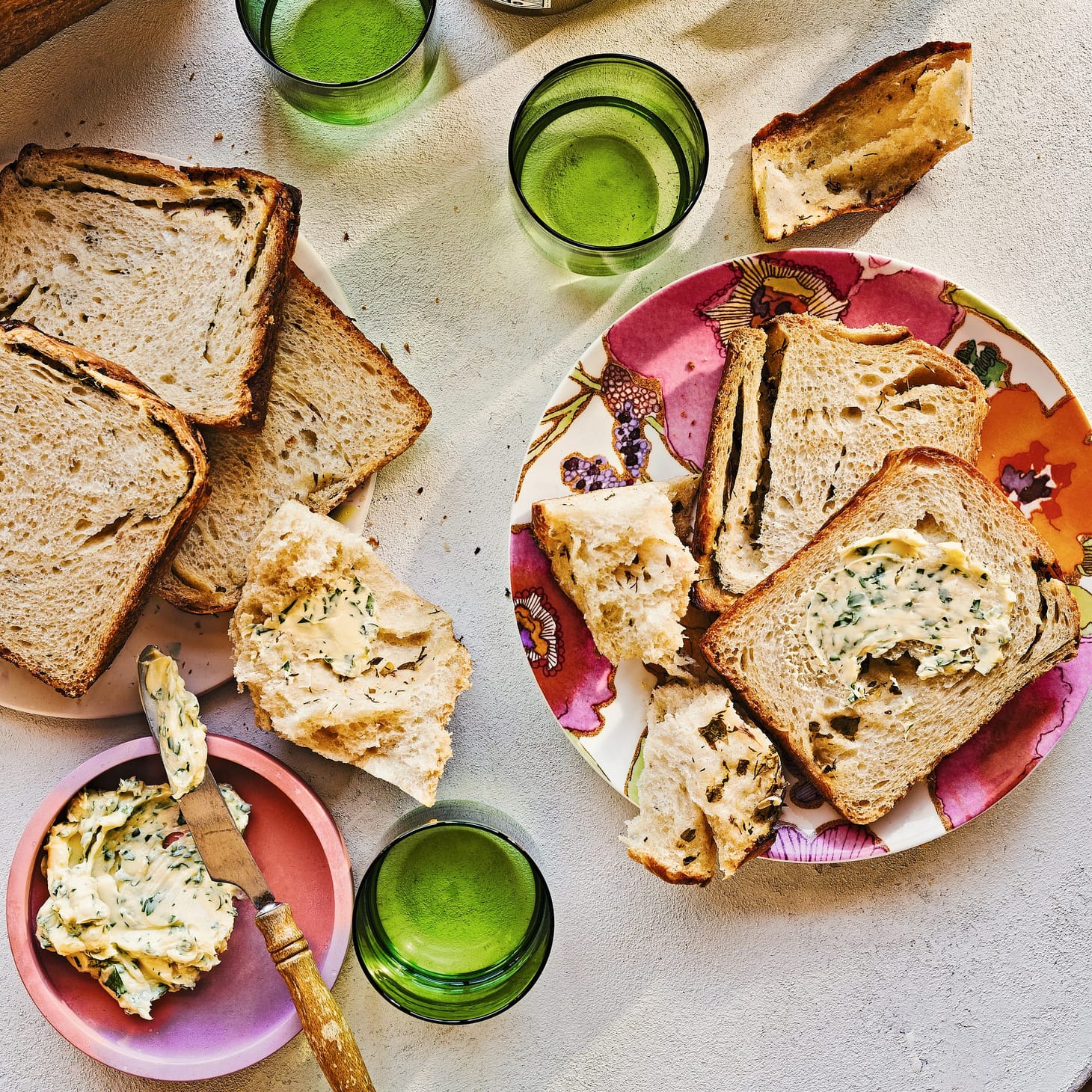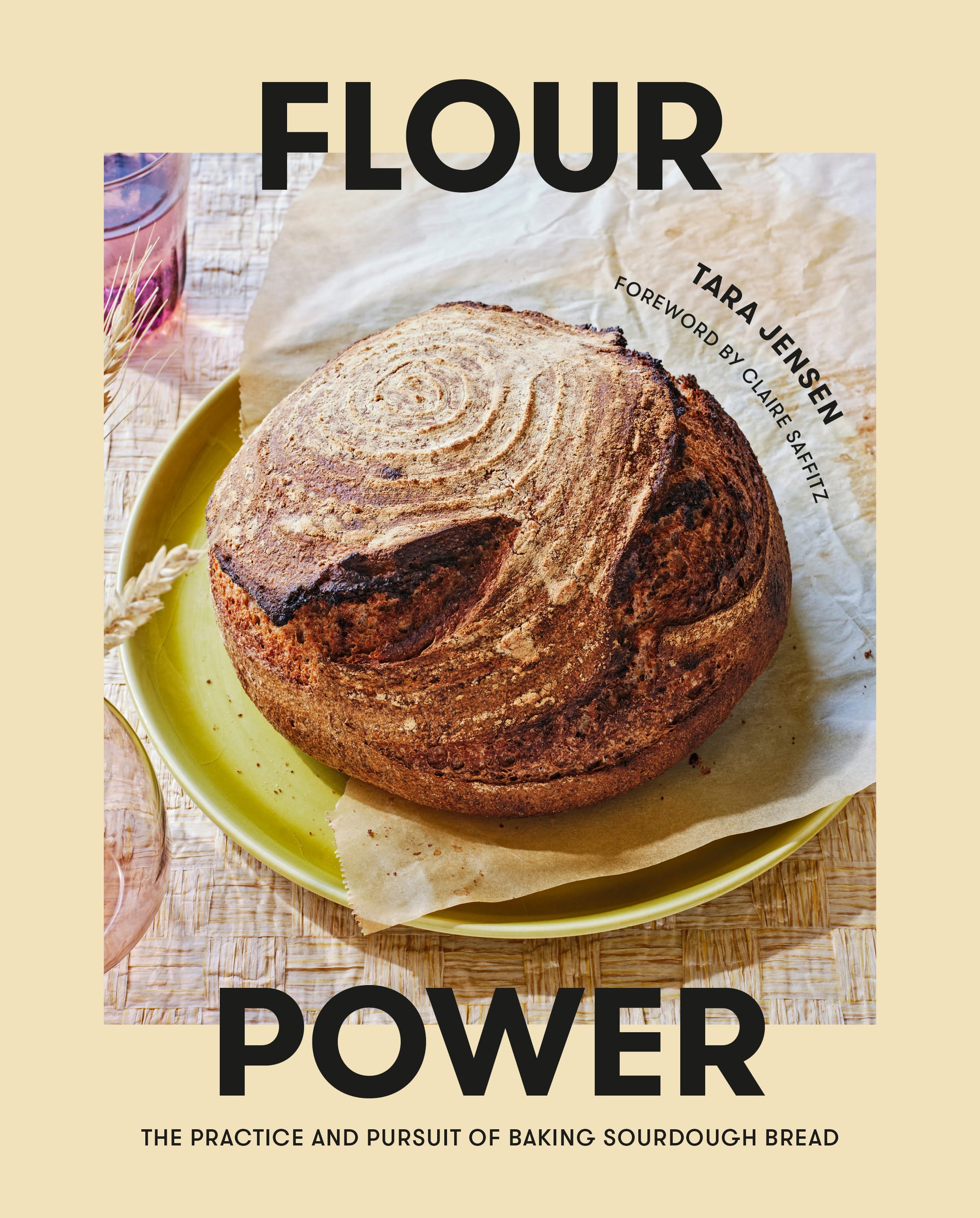Yard Bread Recipe
from Tara Jensen's 'Flour Power'

Table of Contents

Yard Bread20.2MB ∙ PDF fileDownloadDownload
SNAPSHOT: Refresh the sourdough starter and prepare the yard butter 6 to 10 hours before mixing the dough. Thedough is then mixed, folded, and chilled overnight. The following day it is shaped, proofed, and baked.
1 TWISTY LOAF AT 1KG | 9-INCH PULLMAN PAN | DOUGH TEMP: 78°F | LEVEL: ADVANCED
YARD BREAD
This bread is filled with aromatic herbs ideally from your kitchen garden, like rosemary and thyme, combined into butter. The butter is then slathered inside a babka-style twist for a savory delight.
YARD BUTTER
WEIGHTS & INGREDIENTS
113g (1 stick) butter, unsalted, at room temp
20g oregano, fresh, finely chopped
20g thyme, fresh, finely chopped
20g rosemary, fresh, finely chopped
20g lemon zest, grated
4 cloves garlic, minced
DOUGH
BAKER’S % WEIGHTS & INGREDIENTS
80% 430g bread flour
20% 48g whole wheat flour
44% 213g yard butter
40% 215g water
20% 107g eggs, large, room temp
20% 107g sourdough starter
4% 22g vegetable oil
2% 11g salt
THE NIGHT BEFORE: SOURDOUGH STARTER REFRESH AND MAKE THE YARD BUTTER
Following the instructions on page 67, refresh your sourdough starter the night before or up to 10 hours prior to mixing the dough.
Make the yard butter In a stand mixer fitted with the whisk attachment, whip the butter on medium speed until creamy, about 2 minutes. Add the oregano, thyme, rosemary, sage, lemon zest, and garlic. Whip on medium speed until the herbs are evenly dispersed throughout the butter. Using a flexible spatula, transfer the butter to a 1-pint deli container (or similar container) and refrigerate until needed.
DAY ONE: MIXING, FOLDING, AND CHILLING
Mix In a stand mixer fitted with a dough hook, combine the bread flour, whole wheat flour, water, eggs, starter, vegetable oil, and salt and mix on low for 2 minutes. Stop the mixer and scrape down the bowl and hook with a dough scraper. Resume mixing on low speed for another 2 minutes, or until there are no patches of dry flour. Using a dough scraper, transfer the dough to a large bowl.
Pop a digital thermometer into the dough to take its temperature—it should be between 75° and 81°F. (If the dough is above 81°F, stick it in a cool spot—not the refrigerator—until it cools to between 75° and 78°F. If it is less than 75°F, place it in a warm location until it reaches between 75° and 78°F.) Cover the bowl with a dinner plate or sheet pan for a lid and let rest for 1 hour.
Fold Once the dough is relaxed, you will give it a series of three folds spaced 1 hour apart. To fold, smear a little water onto your work surface.
Using a dough scraper, gather the dough together and, with a quick motion, scoop the dough up with the dough scraper and flip it onto the wet table. Using your hands, lift the dough off the table, then slap the bottom half down, so that it sticks a little. Gently leaning back, stretch the dough and then quickly lean forward, tossing the dough still in your hands over the portion stuck to the table. Repeat three to four times. The dough will become smooth and pull itself into a ball.
Using the dough scraper, return the dough to its container, smooth-side up, cover with the plate or sheet pan, and let rest for 1 hour. Repeat the process two more times, with 1 hour between folding sessions.
Chill After the final fold, transfer the dough back to the bowl, cover with the lid, and refrigerate for at least 8 hours or up to 24.
DAY TWO: SHAPING, PROOFING, AND BAKING
Shape Remove the yard butter from the fridge and let it come to room temperature. Remove the dough from the fridge (no need to let it come to room temperature). Lightly flour your work surface and lightly oil a 9-inch Pullman pan. To shape, turn out the dough onto a well-floured surface. With a rolling pin, gently roll into a 10 × 12-inch rectangle. Using an offset spatula, evenly spread the yard butter over the rectangle, leaving a 1-inch border all around. With a long side facing you, roll the dough into itself, starting from the bottom, working toward the top, making a “jelly roll.”
With a sharp knife, cut the roll down the center lengthwise. You now have two long halves. Place the halves side by side, with the cut sides facing up. Cross at the top to make an X. Twist the two ropes three to four times, always leaving the cut sides up. Use a bench knife to transfer the twist to the oiled Pullman pan with the cut sides facing up.
Proof Loosely cover the pan with a kitchen towel and proof the dough in a draft-free spot at room temperature for 2 to 3 hours. When fully proofed, the loaf will appear to have doubled in size, feel full of air, and pass the poke test (see page 55).
Preheat the oven to 500°F.
Bake When the oven is up to temperature, gently spritz the top surface of the dough with water from a spray bottle before loading it into the oven. (This bread has no score.) Bake at 500°F for 15 minutes. After 15 minutes, reduce the oven temperature to 475°F and bake another 15 to 20 minutes, or until the loaf is deeply browned and reaches an internal temperature of 190°F. Carefully remove the bread from the pan and cool completely on a wire rack. Store for up to 5 days, cut-side down, in a paper bag tucked inside a cloth bag. Smear the yard butter on the dough. Cut down the center.

Reprinted from Flour Power, Copyright © 2022 by Tara Jensen. Photographs copyright © 2022 by Johnny Autry and Charlotte Autry. Published by Clarkson Potter, an imprint of Random House.
wordloaf Newsletter
Join the newsletter to receive the latest updates in your inbox.




